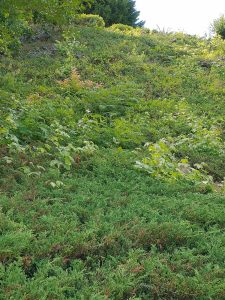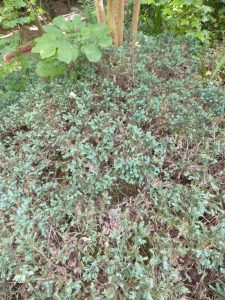
Heather N. Kolich, ANR Agent, UGA Extension Forsyth County
In the past couple of weeks, I’ve noticed an eruption of weeds in juniper ground cover plantings around the county. I saw this same issue last year, too, beginning in March.
Ground covers are generally used as a low maintenance means to control weeds, sometimes in areas that are difficult to access. Creeping junipers (Juniperus horizontalis) are a popular choice for ground cover on slopes, where they also serve to mitigate soil erosion. Evergreen and drought tolerant, creeping junipers are available in numerous cultivars that offer height differences from 6-24 inches and a generous spread that will cover 6-12 feet at plant maturity. For optimum health, junipers need full sun exposure and well-drained soil.
When weeds become a persistent problem in ground covers, it may indicate that the ground cover is thinning and losing its ability to shade out seedling weeds. Numerous stress factors can contribute to juniper thinning, including age, soil conditions, plant spacing, shade, and cultural practices. Stress, in turn, makes plants more susceptible to insect pests and diseases.
Although a U.S Forest Service study found that wild creeping junipers in central Montana had a lifespan range from 20 to 140 years, the environmental conditions of urban and suburban Georgia landscapes shorten that to about 20 years of productive growth before creeping junipers begin to decline. Over the course of that 20 years, all plants in the landscape mature, including trees. Junipers that were in full sun when they were planted may now be struggling to survive in shady conditions. Signs of shade stress are leaf tip browning, dieback, and thin or dead areas within the planting.
Junipers are susceptible to fungal root rots when they are overwatered or the soil remains wet due to poor drainage. Death of the entire plant or group of plants is a sign of root rot. Because the pathogen can remain active in the soil, replanting with another juniper is not recommended.

Junipers are hardy and tolerant of many soil types, but they still need fertilizer to maintain health and growth. For each 100 square feet of planting area, provide ½ pound of 16-4-8 or 12-4-8 granular fertilizer. Water the fertilizer in immediately after application.
Unfortunately, controlling weeds that grow up in large juniper plantings can be challenging. Below are some herbicides and guidelines for post-emergence weed management in juniper beds.
Herbicides for Emerged Weeds in Junipers
Weed identification is important for selecting the appropriate herbicide to apply. Postemergence herbicides work best on young weeds in active growth. They are less effective – or may be ineffective – on mature weeds and weeds that are not actively growing due to factors such as drought, stress, or seasonal decline. Hand removal may be necessary for tree seedlings and established broadleaf weeds.
Sulfosulfuron (the active ingredient in Certainty 75DF) can be applied around established junipers and some other established woody ornamental plants. It provides excellent control of yellow and purple nutsedge and good control of wild garlic, clover, lespedeza, and several other broadleaf weeds.
Clethodim (Envoy Plus) and sethoxydim (Segment II, Vantage) can be applied over the top of junipers for good to excellent control of perennial grasses and some annual grasses. Clethodim offers excellent control of annual bluegrass, but sethoxydim does not.
Herbicides have different modes of action and results may not be evident immediately. With clethodim, for example, effects should be visible 1-2 weeks after treatment, when affected grasses turn yellow and show weakness before collapsing. The product label provides information about how the chemical affects plants and when to expect results.
Use Herbicides Correctly
Always read and follow the directions on the product label. For some products, complete directions are in a fold-out booklet sealed to the container. For more readable options, look for labels and Safety Data Sheets online.